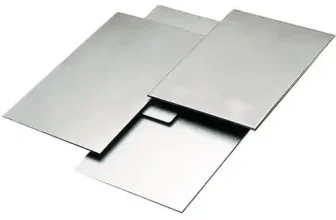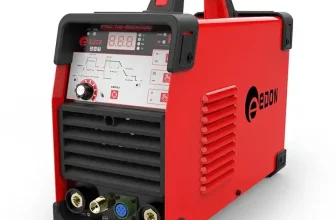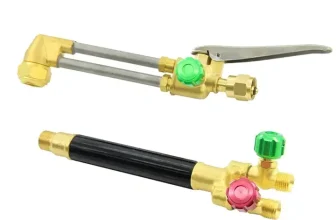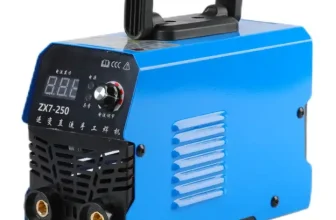A flux core welder is a type of welding machine that uses a unique process known as Flux-Cored Arc Welding (FCAW). This welding method uses a continuously-fed electrode tube filled with a flux material, which becomes the protective shield against contaminants in the atmosphere instead of relying on a separate external shielding gas. When the arc generates heat, it melts the flux-filled electrode, thereby creating the weld pool to join metal pieces together. The flux material also generates gases when heated, forming a shield around the weld area to protect against atmospheric elements that could compromise the strength and quality of the weld.
Brief overview of the process of welding
Welding is an essential fabrication method used extensively in different industries. It is the process of joining two pieces of metal by applying heat, causing the metal pieces to partially melt and fuse together. The process often involves adding filler material to the melted pool to reinforce the joint and fill gaps. When the heated metal cools off, a durable and often permanent connection is established. Welding techniques and standards vary depending on several factors, including materials used, thickness of the metals, and application requirements. Types of welding include Stick, MIG/Flux Core, TIG, and more. Among these, Flux Core welding stands as a popular choice due to its several unique features, as will be discussed in this article.
History and Development of Flux Core Welding
Origin and early use
Flux Core Welding finds its roots in the early 1950s as a result of the necessity for faster, more efficient welding methods in the construction and fabrication industries. It was during this post-WWII period that industries were rapidly growing, and the demand for a welding technique that was faster and didn’t require high-level skill rose significantly.
The concept of Flux Core Welding was developed and patented by Bernard Welding Equipment and was originally known as Innershield. At its inception, it was incredibly revolutionary for the time. Flux Core Welding gained early popularity primarily because unlike other welding techniques, it didn’t require the use of a shielding gas to protect the weld pool from contamination. Instead, it relied on a hollow wire electrode that was filled with flux. This enabled welders to use this technique outdoors, under windy conditions where traditional welding techniques would fail.
The early applications of Flux Core Welding were primarily in the shipbuilding industry and heavy machinery manufacturing, where large welding tasks were common. The Flux Core Welding technique provided the much-needed speed, efficiency, and adaptability, making it instantly popular in these sectors. Over time, it became a go-to welding method for a variety of structural applications, demonstrating its versatility and effectiveness.
Advancements and improvements over time
As with most technological innovations, flux-core welding has witnessed remarkable advancements over time, since its inception in the mid-1950s. Initially, the equipment was large, bulky, and less efficient, restricting its use to specific applications and industries. Over the years, significant changes have reshaped its design and functionality, amplifying its use and benefits.
Technological strides have introduced wire feeders that are less complex and more reliable. This improvement has enabled higher productivity rates and more extensive use in a wider range of applications. Polarity is another major area of improvement. Early models used only direct-current electrode negative (DCEN), but today’s flux-core welders can use either DCEN or alternating current, depending on the wire and the application.
Flux core welders have also seen improvements in the range of materials they can weld. Initially, they were limited to low-alloy and carbon steel welding. But current models can also weld various types of stainless steel which greatly broadens their versatility in the industrial world.
Further improvements have been made from the angle of safety. Newer flux-core models have more advanced cooling mechanisms to prevent overheating and protect operators from severe burns. Designs have also been focused on minimizing harmful fumes, leading to safer working conditions and less pollution.
Additionally, the current flux-core welders are more portable than their predecessors. They are now smaller, lighter, and easier to handle, making them useful in locations where larger, traditional machines were unsuitable.
Overall, the journey of flux core welding technology from its infancy to its current state shows relentless progress and a remarkable alignment with changing industry needs and safety standards. And there is no doubt that this golden thread of evolution will continue in the future with an increase in technical capabilities, digital interfaces, and overall process efficiency.
Different Types of Flux Core Welders
Self-Shielded Flux-Cored Welding (FCAW-S)
Self-Shielded Flux-Cored Welding (FCAW-S) is one variety of flux core welding that does not rely on an external shielding gas to protect the weld from atmospheric elements. In this type, the shielding is provided by compounds within the flux that generate a protective gas when heated.
This has an advantage when working in windy or drafty environments where an external shielding gas could easily dissipate, making it impractical. It is also beneficial when mobility is a priority, as carrying a tank of shielding gas is not necessary.
FCAW-S is often used in construction due to its adaptability and ease of use in outdoor scenarios. It also delivers excellent penetration into thicker materials and allows for welding in all positions. But it’s important to note that this type of welding usually produces a lot of spatter and smoke and may require greater cleanup compared to other forms.
Gas-Shielded Flux-Cored Welding (FCAW-G)
Gas-Shielded Flux-Cored Welding (FCAW-G) is the second major type of flux core welding. Despite sharing a similar name with Self-Shielded Flux-Cored Welding (FCAW-S), the welding process has a significant difference – it uses an external shielding gas. This gas further protects the weld pool from contamination and assists in creating a stable, efficient arc.
The shielding gas used in FCAW-G can either be pure CO2 or a blend of argon and CO2. The choice of gas often depends on the specific welding job at hand, as different gases have unique characteristics that affect bead shape, penetration, and overall weld quality.
One of the primary advantages of FCAW-G is its ability to produce welds of superior quality compared to FCAW-S. The external shielding gas used in this process helps in reducing weld spatter and improving overall weld appearance, thus often making it the preferred method for critical welding jobs that require high levels of precision and cleanliness.
Nevertheless, this process also has its challenges. Because an external gas source is required, FCAW-G is less portable and more complicated to set up than FCAW-S. Shielding gas also makes the process more susceptible to wind and drafts, making FCAW-G less ideal for outdoor welding projects.
How does a Flux Core Welder Work?
Welding Process
Flux core welding operates on the principle of electric arc welding. In this process, an electric arc is formed between the base metal and the electrode, or wire, being used for welding. This arc then heats the metal, melting both the base metal and electrode to form the weld.
The welding process begins when you squeeze the trigger on the welder’s gun, sending electric current down a copper contact tip that extends into the gun’s nozzle. The wire electrode goes through the center of the contact tip, and the flow of current between the contact tip and the wire heats the wire to its melting point.
As the wire feeds out of the gun, it comes in contact with the base metal and melts, forming a weld pool. The flux in the wire melts simultaneously, releasing vapors that act as a shielding gas to protect the weld from contamination from the surrounding air.
In simple terms, the flux core welding process involves feeding a continuous wire electrode through the welding gun, where it makes contact with the base material and creates the weld. The molten metal cools and solidifies quickly, leaving behind a weld bead that joins the base materials together.
Main components and their functions
Flux core welders work by using the heat created by an electric arc, this happens between a continuously fed wire and the metal workpiece. The wire used has a flux compound in its core that vaporizes during welding to shield the weld from contamination. This procedure has different components performing specific roles.
-
Gun: The welding gun of the flux core welder introduces the flux core wire into the weld joint. It also provides the electrical energy needed to create the arc. This gun is lightweight and designed to be easy to control for precise operation, ensuring a sound and clean weld.
-
Ground Clamp: The ground clamp serves as the return path for the welding electricity. It is clamped onto the workpiece or the welding table, forming a closed circuit along with the welding gun.
-
Wire Feed Assembly: This component guides the flux-cored wire from the wire spool straight to the welding gun. It consumes power from the main unit and maintains a steady feed rate, which is vital to achieving a steady and consistent weld.
-
Welding Wire: This is the main consumable in flux core welding. The wire is fed through the gun into the weld joint where it is melted by the electrical arc. The molten wire then solidifies to form the weld.
-
Power Supply or Welding Unit: It provides the electrical power needed to create the welding arc. Most flux core welders are equipped with a power control feature to adjust the intensity of the arc according to the specific welding tasks, enabling it to work on different metal thicknesses.
-
Shielding Gas: While not always required, some flux core welders utilize a shielding gas for the welding process. This gas shields the weld area from the ambient air, avoiding oxidation and ensuring a cleaner weld.
Understanding the main components of a flux core welder is vital to mastering its operation and ensuring a solid, clean weld. In particular, recognising when to replace or maintain certain components can greatly improve the longevity and effectiveness of the welding machine.
Safety tips during operation
Safety is paramount when working with a flux core welder, as there are potential hazards including exposure to ultraviolet and infrared light, dangerous fumes, and the risk of burns from hot materials.
Wear protective clothing, including a welding helmet with a correct shade of lens, gloves, and flame-resistant clothing to protect yourself from sparks, spatter, and radiation. It’s also advisable to use a welding respirator, especially when welding in a confined space, to avoid inhaling potentially harmful fumes.
Maintain a well-ventilated area to disperse welding fumes. Don’t weld near flammable materials. Instead, maintain a clean, dry work area with all cords and hoses safely stowed away to reduce the risk of tripping or entanglement.
Before you begin welding, ensure the equipment is in proper working condition. Regular inspection and maintenance of the welder can prevent problems during operation and prolong the life of the equipment.
Avoid touching live electrical parts and always switch off the power supply before adjusting electrical parts or changing wires.
Finally, be prepared for potential emergencies by having a fire extinguisher nearby, and keep a first-aid kit handy. Other personnel nearby should be informed when welding activities are going on, as they may also need to take necessary protective measures.
Following these safety measures can help ensure you carry out your flux core welding tasks effectively and safely.
Benefits and Drawbacks of Flux Core Welding
Advantages
The advantages of flux core welding are numerous, making it a preferred choice for many enthusiasts and professionals in the welding field. First and foremost, it enables high welding speeds, which can significantly boost productivity. This is primarily due to the fact that it doesn’t require the constant changing of rods as is the case with stick welding, therefore reducing downtime.
Secondly, flux core welding stands out for its exceptional versatility. Unlike other forms of welding, such as TIG (Tungsten Inert Gas Welding), you can weld various types of metals and alloys of different thicknesses using a flux core welder. The process is also less affected by drafts, making it suitable for outdoor welding projects.
Another significant attribute lies in the quality of welds it produces. With a flux core welder, you are assured of deep penetration, typically resulting in stronger, more durable welds, an advantage especially for construction and industrial applications.
Furthermore, flux core welding doesn’t necessitate any external shielding gas, which simplifies the process and reduces overall costs. Plus, it’s worth mentioning the welder’s ease of use, which allows beginners to get to grips with the process quickly, reducing the learning curve.
And finally, perhaps the most notable of all its strengths, flux core welding is known for its ability to handle dirty or rusty material better than most other welding methods. This gives it a significant edge in repair works and field applications where the condition of the welding surfaces can’t always be perfectly prepared.
Disadvantages
Despite the numerous advantages of flux core welding, there are several disadvantages that one should be aware of, especially in terms of decision making. One of the primary drawbacks of flux core welding is the smoke and fume produced. The high amount of fumes can often obscure the weld, posing a challenge for the welder.
Another significant disadvantage is the difficulty in wielding this technique on thinner materials. The method’s intense heat input can easily lead to burning through the metal before a proper weld can be established. Thus, for those working with delicate or thin materials, this may not be the best option.
Flux core welding can also be limiting due to its lack of versatility. While it’s excellent for certain types of tasks, particularly those involving thick and strong metals, it is not well-suited for tasks that require more finesse and attention to detail.
Lastly, it’s worth mentioning that the cleanup process after flux core welding can be extensive. The method can often leave a slag, requiring post-weld cleanup. This not only lengthens the welding process but also leaves room for mistakes during the cleanup process that could negatively affect the final product.
Uses and Applications
Professional applications and industries
Flux core welders are extensively used in several professional industries due to their robustness, efficacy, and versatility. One prominent field where these devices shine is the industrial construction sector. Their ability to work with thick materials and perform faster than other welding types makes them an ideal choice for erecting buildings, bridges, and other heavy-duty structures.
Similarly, in the shipbuilding industry, where large metal end parts are commonly used, flux core welders are an invaluable tool. They are preferred due to their capacity to withstand harsh environments and create strong, sustainable bonds that can stand up to the rigors of sea travel.
The automotive industry also utilises these welders for vehicle assembly and repair tasks. Their ability to create beautiful beadwork and penetrative welds helps ensure a secure bond between different vehicular components.
Additionally, the use of flux core welders in manufacturing pipelines is noteworthy. Whether it’s oil, gas, or water transport, these machines offer a high-speed welding process that is crucial in the pipeline industry. The welders are also appreciated for their knack in resisting windy conditions, which is a common encounter in pipeline laying projects.
Finally, these welders are used in the repair and maintenance workspace for applications like heavy machinery repairs, agricultural equipment maintenance, and other similar tasks. Given their ease of use and convenience, flux core welders are the go-to tools for a multitude of professional applications across diverse industries.
DIY and home use
Flux core welding isn’t just confined to professional applications, it is also ideal for DIY projects and home use. Its easy set-up and operation allow even beginners to engage in flux core welding. Hobbyists and DIY enthusiasts often use it for performing quick repairs or building metal projects around the home.
It’s great for a variety of home renovation projects such as fixing a metal railing or a broken garden tool. For more complex tasks, like crafting a backyard fire pit or constructing a metal shelf, flux core welders come in handy. Additionally, their ability to weld thick materials makes them well-suited to heavy-duty home projects.
Given their relatively simple operation, flux core welders can be safely used at home with appropriate protective equipment and precautions. Therefore, it isn’t just for the professional construction industries – it’s also a reliable tool for the home handyman.
Characteristics to Look For When Buying a Flux Core Welder
Capacity and power
When considering the purchase of a Flux Core Welder, the first characteristic to look at is its capacity and power. The power output of a Flux Core Welder is commonly rated in amperage. This typically ranges between 70 to 500 amperes, with most hobbyist models sitting in the 100 to 200-ampere range. The power rating determines the thickness and the type of material the welder can handle. For example, a 70-ampere welder might be suitable for thin sheet metal, while a 200-ampere welder can handle thicker materials such as steel or iron.
You should definitely consider your intended use and the primary materials you will be welding. If you’re looking for a welder for small household tasks and repairs, a lower power unit will suffice. However, if you plan to work on more substantial or commercial projects, you will need a welder with higher amperage for better penetration and stronger welds.
In terms of capacity, you must check the duty cycle of the welder. The duty cycle is a rating that informs users how long the welder can operate within a specific timeframe before needing a cooling period. For example, a welder with a duty cycle of 20% at 100A means it can operate continually for 2 minutes and then cool down for the next 8 minutes. So, if your welding tasks require long and continuous operation, look for a Flux Core Welder with a higher duty cycle.
Ultimately, the capacity and power of the flux core welder you choose should correspond to the nature and scale of the welding projects you’re planning to undertake. Investing in the right welder can save you time and money while ensuring a smooth and efficient welding process.
Size and weight
Size and weight play a crucial role in selecting the ideal flux core welder for one’s needs. If portability is a key factor, especially for tasks such as field repairs or if the user intends to move the welder around a lot, then a lighter, smaller model would be the best fit. Smaller welders often weigh about 40 to 50 pounds, making them relatively easy to transport.
However, do not be deceived by size alone. Smaller welders featuring inverter technology can pack a powerful punch in a compact package. Such models are perfect for homeowners and casual DIY enthusiasts who need a portable yet powerful tool.
On the other hand, for heavy-duty industrial applications, larger, heftier flux core welders are better suited. These models, which often weigh over 80 pounds, offer greater power and duty cycles, necessary for intense, larger scale welding projects. Keep in mind that these larger models might require a designated workspace due to their size and weight.
In essence, the preferred size and weight of a flux core welder will largely depend on its intended use. Weigh carefully between portability and power requirements before making a buying decision.
Add on features
While looking at the basics is always a good starting point when buying a flux core welder, it also pays to consider some additional bonus features that can enhance the functionality and versatility of the tool. For instance, consider whether the welder includes a thermal overload protection, a feature that helps prevent machine damage by automatically turning off the welder when it becomes too hot.
Another desirable feature is an automatic feed control, allowing for smoother and easier operation. Multi-voltage options can offer great flexibility in terms of where you can use the welder, while an adjustable wire speed feature allows you greater precision for specific tasks. Some flux core welders even come with welding wire included, which can be a useful cost-saving consideration.
Including certain accessories like a spool gun can significantly facilitate welding procedures for specific materials like aluminum. Furthermore, inbuilt contactor and inverter technology can also be great value-adds, enhancing safety and efficiency, respectively.
While these extra features may not be essential, they could certainly be worth considering as they can add invaluable convenience and functionality to your flux core welding experience. However, it is also important to balance this with cost considerations and whether you will genuinely use these features. It all comes down to fully understanding your welding needs and how a certain machine can cater to them in the best way possible.
Conclusion
Recap and the importance of understanding Flux Core Welders
Flux core welders have undeniably revolutionized the welding industry with their versatile and efficient performance. From understanding their basic functioning to recognizing their history and development, it’s crucial for anyone engaging in welding tasks to comprehend the true value these machines bring to the table.
When it comes to their operation, flux core welders stand out for their simplicity and robustness, making them valuable tools for both professionals and DIY enthusiasts. The insight into the two types, FCAW-S and FCAW-G, with their specific properties, reinforces the versatility of flux core welding.
It’s noteworthy that having a balanced view of their benefits and drawbacks enables users to suitably employ these welders, augmenting their efficiency. Their numerous applications across industries and for home use further underline their practicality and broad utility.
Given the rapid advancements in technology, flux core welding is poised to keep evolving, making this knowledge even more relevant. Therefore, understanding what to look for when purchasing one becomes even more critical. From capacity and power to size, weight, and add-on features, these are key considerations that can make a significant difference in welding outcomes.
In essence, comprehension of flux core welders not only allows for effective utilization but also promotes safety, economy, and superior results. As technology marches on, the future of welding is rendezvousing with more sophisticated, user-friendly, and efficient versions of these machines, priming flux core welding for an era of new possibilities.
Future of welding technology.
As technology continues to advance at a rapid pace, so too does the world of welding. Industry experts anticipate the future of welding technology as being significantly influenced by automation and robotics. This aligns with the need for enhanced precision, productivity, and safety in numerous sectors, including automotive, aerospace, manufacturing and construction.
Artificial Intelligence (AI) is expected to make a sizeable impact as well, with smart welding solutions that can self-adjust and learn from previous tasks, drastically reducing errors and inefficiencies. Augmented Reality (AR) and Virtual Reality (VR) systems are also poised to revolutionize training methodologies, allowing for more immersive and practical learning experiences without the usual risks associated with welding.
In addition, advancements are being made on the materials side as well, aiming to develop superior grades of flux-cored wire to improve the welding process even further, making it easier, more efficient and powerful.
However, it is crucial to remember that as promising as these developments may be, human skills and expertise will remain central to the profession. No amount of technological innovation can replace the analysis, decision-making and problem-solving capacities that human welders bring to the workbench.
The future is indeed bright for welding technology, promising an exciting blend of human craftsmanship, robot precision, and smart solutions to push the boundaries of what is possible in this field.







